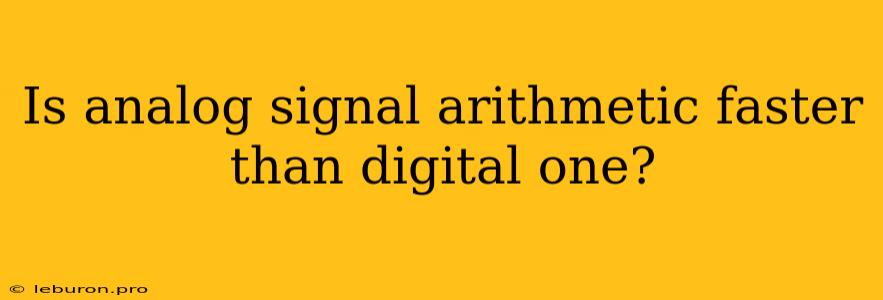The question of whether analog signal arithmetic is faster than digital signal arithmetic is a complex one with no simple answer. While analog circuits can perform certain calculations in a continuous and seemingly instantaneous manner, the speed of digital signal processing has advanced dramatically in recent years, making it a powerful tool for many applications. To understand the nuances of this comparison, we must delve into the underlying principles of both analog and digital signal processing and analyze their respective strengths and weaknesses.
The Nature of Analog and Digital Signals
Analog signals are continuous representations of physical phenomena, such as sound waves, light waves, or temperature variations. They vary smoothly over time, mimicking the original signal's behavior. In contrast, digital signals are discrete representations, quantifying and encoding information into a series of binary digits (bits). This quantization process converts continuous values into a finite set of discrete levels, representing the signal at specific intervals.
Arithmetic in Analog and Digital Domains
Analog arithmetic relies on the physical properties of circuits and components, such as resistors, capacitors, and operational amplifiers. By manipulating voltage and current levels, analog circuits can perform basic arithmetic operations like addition, subtraction, multiplication, and division. The speed of analog arithmetic is often limited by the response time of the circuit components and the inherent non-idealities of the analog domain.
Digital arithmetic, on the other hand, operates on binary representations of numbers. Using logic gates and specialized circuits, digital processors can execute complex algorithms and perform calculations with high precision. The speed of digital arithmetic is primarily determined by the clock frequency of the processor, the efficiency of the algorithms used, and the architecture of the processing unit.
Analog Arithmetic: Advantages and Disadvantages
Advantages:
- Potential for High Speed: Analog circuits can operate at very high speeds, potentially exceeding the processing capabilities of some digital systems.
- Simplicity in Certain Operations: Analog circuits are well-suited for tasks like filtering, amplification, and basic mathematical operations, often requiring less complex circuitry than their digital counterparts.
Disadvantages:
- Limited Accuracy: Analog circuits are susceptible to noise, drift, and component tolerances, which can introduce errors into calculations.
- Difficulty in Complex Operations: Implementing complex algorithms or performing advanced computations in the analog domain can be challenging and require sophisticated circuit designs.
- Limited Flexibility: Analog circuits are typically designed for a specific task and lack the flexibility of digital systems, which can be easily reprogrammed for different operations.
Digital Arithmetic: Advantages and Disadvantages
Advantages:
- High Accuracy: Digital processing allows for precise calculations with minimal error due to the nature of binary representation and the use of error correction techniques.
- Flexibility and Reconfigurability: Digital systems can be easily programmed to perform a wide range of complex operations and adapt to changing requirements.
- Scalability: Digital processors can be scaled to handle increasingly complex tasks, providing significant processing power.
Disadvantages:
- Potential for Latency: While digital processing has achieved impressive speeds, certain operations can introduce delays, especially in complex algorithms.
- Power Consumption: Digital systems often consume more power compared to analog circuits, particularly for high-performance processors.
- Conversion Overhead: When working with real-world analog signals, conversion between the analog and digital domains can introduce delays and impact processing time.
Speed Comparison: A Closer Look
Determining whether analog or digital arithmetic is "faster" requires considering the specific context and the nature of the operation. For simple operations like basic arithmetic, analog circuits can be incredibly fast, especially in specialized applications. However, for complex computations, the flexibility and precision of digital systems often outweigh the potential speed advantage of analog circuits.
Examples:
- Signal Filtering: Analog filters are known for their speed and efficiency in processing signals in real-time. However, digital filters offer greater flexibility in terms of filter design and implementation, allowing for more complex filtering techniques.
- Image Processing: Digital image processing relies heavily on complex algorithms and large datasets, making digital systems a clear choice for this application.
- Scientific Computing: High-performance computing relies on digital processors to tackle massive computations with high accuracy, essential for fields like physics, chemistry, and finance.
Conclusion
The speed comparison between analog and digital arithmetic is not a straightforward one. While analog circuits can be extremely fast for certain operations, digital signal processing offers greater flexibility, accuracy, and scalability, making it the preferred choice for many applications. As technology continues to evolve, the boundaries between analog and digital signal processing will continue to blur, with hybrid approaches becoming increasingly common. The choice between analog and digital arithmetic depends heavily on the specific requirements of the application, including factors like speed, accuracy, complexity, and flexibility.
